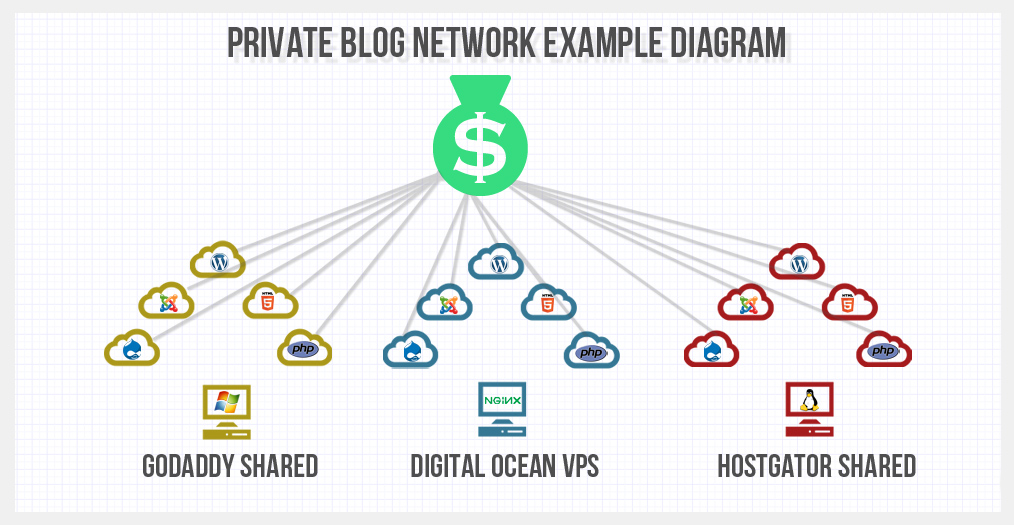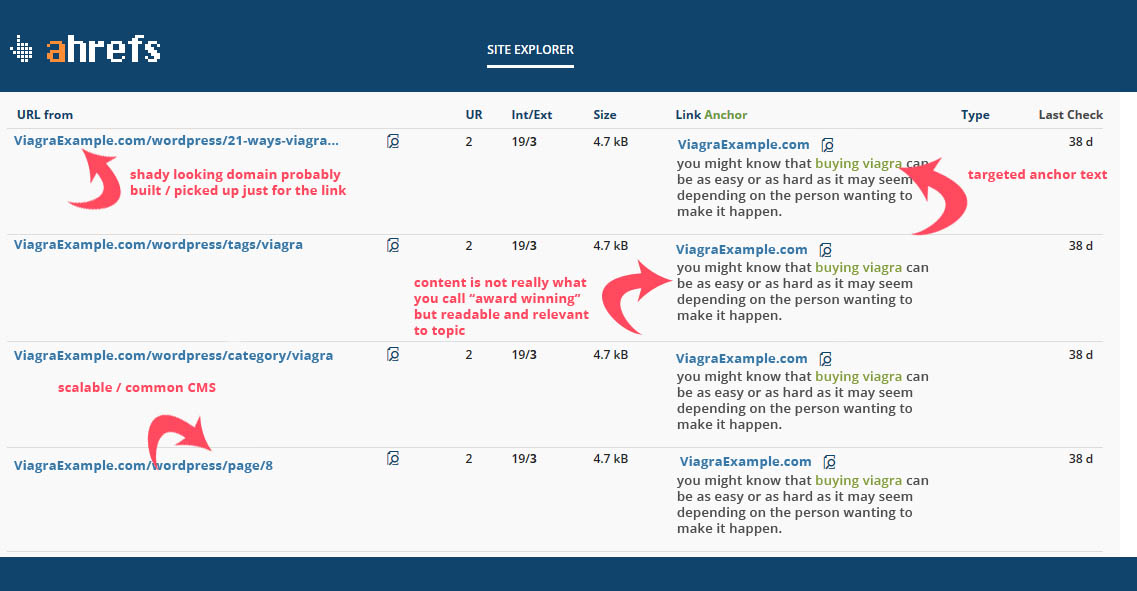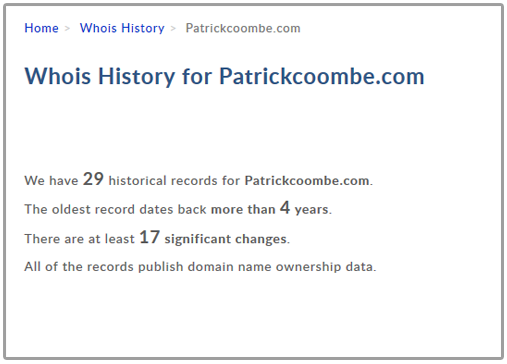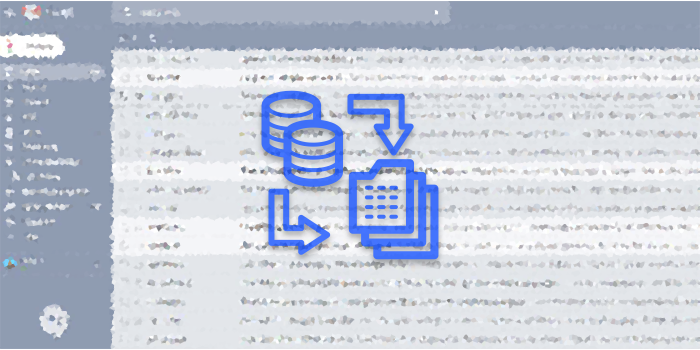Spying on your competitors private blog network

The best blackhat SEO’s in the world are the ones that look like whitehats.
Today I’m going to take competitor research to the next level. We’re going to define, identify, and analyze the private blog networks your competitors are using to rank and bank.
But why are we doing this? That is really something you have to answer yourself. It doesn’t matter if you are white, black or grey hat it pays to know what your enemy competitor is using as a ranking strategy. You might have a variety of motives, good or bad:
- maybe you want to copy their strategy
- negative SEO their PBN
- report them to Google
- send them a holiday card
- store the information for use at a later date
Personally I am just nosy. I like to see what my competitors are doing to rank and how they are doing it. I’ve been doing SEO competitor research since before I was even an SEO.
I’ve personally used PBN’s as a strategy pre-Penguin 1.0 or what I refer to as “the glory days” but has since abandoned as I do not feel it is a viable ranking strategy anymore. Yes it may still “work” on some level but I am just not down with that anymore. No, I am not perfect and don’t claim to be squeeky clean but I generally utilize mostly whitehat techniques.
Locate your competitor
Who are we going after? SEO competitors pop up on my radar all the time. A lot of times I’ll notice them when they start ranking for a competitive keyword over night. One keyword I watch all the time is “Florida SEO.” It is a super lame keyword that drives low quality traffic but for some reason every Tom, Dick and Harry wants to rank for it. A lot of times I see sites with PBN’s rank for that keyword.
Most of the time you already have the website in mind you want to find out. If you have more than one website I advise you to stick with one at a time, as this analysis can get extremely detailed in some cases.
However you decided to find your competitor, this process does involve starting with a URL so figure that out and get ready for the next step.
Amalgamate evidence
Now lets start to look at their backlink portfolio. I use Ahrefs which I consider the best, and have been using for 5+ years.. Dig in. Start manually checking through each and every backlink. I like to check the referring domains, that way I can quickly sift through all of them at once.
Ideally you are looking for something like this:

Quit outing! Example data used
Note that none of these metrics alone means it is a private blog network, but all of them together will mean that it more than likely is.
Fact: not all dropped domains are on PBN’s and not all PBN’s use dropped domains. For some reason that has been the source of arguments over the years but it is just not the case. A PBN can be anything you want it to be:
- a network of dropped domains rebuilt for original purpose
- a network of dropped domains rebuilt for a similar purpose
- a network of newly registered domains
- a network of premium domains
Basically it is a network of websites that is reserved for private use used for backlinking and generally the links are not for sale. Once the links to become for sale it is then considered a “blog network” with the ‘P’ dropped.
Keep digging through their backlinks. The more of these domains you find, the higher the likelihood that your competitor is using a PBN. Put aside (in notepad or whatever) any domain that is a red flag.
Sift through anchor links by anchor text. A skilled PBN owner will know not to use targeted anchor text for every link. They will use branded anchor text, random anchor text and even plain URL’s or image URLs. Don’t let this throw you off.
Throw all of your “maybe’s” into a text file and move on.
Fingerprinting a PBN
A highly skilled PBN creator will be laughing at this part. On the other hand a lot of PBN owners are lazy and are only looking for quick results. What most of them don’t realize is that if a bozo like me can fingerprint a PBN with a few tools, Googlebot already did. At this point you should start worrying.
One of the first things you can do is run a “reverse IP” check on the domains you found linking to the money site. There are a number of ways to do this from the command line, but the quickest way is to use an online tool. Please note that most of these tools use a database that they’ve scraped over they years, so more than likely the list will only partially be accurate.

Quit outing! Example data used
Essentially what this tool does is show you other websites that are sharing the same IP address as the one you entered. Once you have the first IP of the first website in your list, it is usually pretty easy to grab the rest.
If a PBN is housed on “SEO hosting” (I really hate that term) or a host that allows multiple IP addresses the above method will not work, so you will need to use another method.
The fact is, most PBN’s are hosted on a “shared” hosting plan that shares an IP address with sometimes hundreds of other websites. Chances are {some|most|all} of these websites are part of the PBN.
Next, check the PBN’s own interlinking strategy. Some PBN’s interlink within each other, most don’t. A lot of the time you can pick up some easy wins by checking sitewide links.
If you really aren’t sure you can start doing some more advanced fingerprinting. You can run a linguistics analysis to see if any of the posts match a particular writing style. You can run other tests such as domain privacy checks to see if any of them have shared nameservers. For instance if 5 of your domains all have the nameservers:
ns1.example.com
ns2.example.com
That increases the likelihood of those domains belonging to a PBN.
There are many other tests you can run. You’ll find that the smartest PBN owners have sites with the least in common. I’ve seen PBN’s so sophisticated that every last detail of the site is changed down to the server, CMS (or lack there of), frequency of content, add-ons / widgets etc.
Another strategy you can use is check the archive.org history of the domain. Was the domain dropped and then picked back up under a new owner? Was it rebuilt using the original design and content 3 years later under a new owner?
All of this evidence, or lack thereof can count towards identifying a PBN.
One of the most badass-tools in my repertoire is the domain history tool. Not a lot of people talk about this tool, but it seriously rocks. It is a paid tool but it is well worth whatever the cost is.
It is one of the few tools that can also do a decent job of inferring who the owner of a domain is (or is not.)

The cool thing about this tool is it will attempt to grab the whois details from the domain from the period between when they registered the domain and added privacy. You see, many times a domain owner will wait 1-2 weeks to add privacy to a domain. During that time the information is readily available to the public and may or may not get scraped by this tool.
Mentally assess the domain
Touch the domain. Feel the domain. Does it serve a purpose? Is there something funny about it you just can’t put your finger on? A savvy PBN owner will disguise a website as having an actual purpose. This might look like:
- a local business complete with address and phone number
- an organization with logo and about us page complete with company staff photos
- a working app
- a non-profit group
- even eCommerce websites
Keep in mind that many PBN owners scrape old websites from archive.org, so just because a website looks “legit” does not mean that it is. Most of the time people can get away with this because if a domain has dropped, many times that means the company will cease to exist.
The fact is most PBN owners just don’t work this hard. I’d venture to guess that 80% of the PBN’s out there are on some sort of Linux hosting, are running WordPress, Joomla or Drupal and have poor to moderately good content.
Some PBN’s are extremely sophisticated. I’ve seen PBN’s with 500 pages with excellent content that exist just to drop 1 link within 1 piece of content buried within an inner page. You gotta watch.
There are many other ways to identify PBN’s. If you know the URL of money sites your competitor has, you can run a backlink check on them and work your way backwards from there.
What to do
I like to arm myself with as much information as possible about my competitors and their tactics.
If you are reading this as an SEO consultant, listen carefully. Your job is to rank websites for your clients and your agency. Armed with the knowledge that your competition is using a PBN, you now have key information to be used at a later date.
For instance if you are getting yelled at by your client wanting to know why XYZ widgets is ranking higher than you are, you might want to present this evidence to show some of the ‘shady’ tactics they are using.
Personally, I do very little if I find out my competitors are using PBN’s, after all most of them are. It is not really how I like to use my time. Knowing a competitor is ranking using a PBN can be reassuring if you are a whitehat SEO that is struggling to rank. Knowing that they had “help” can be a key indicator into estimating how long or how much extra link juice you will need to meet your goals.
You can also sign a “PBN severity score” to them if you like. For instance one client might only have 4 referring domains from a PBN, while another might have thousands.
Well, it is starting to get real 2010 up in here so I’m gonna end with that.



